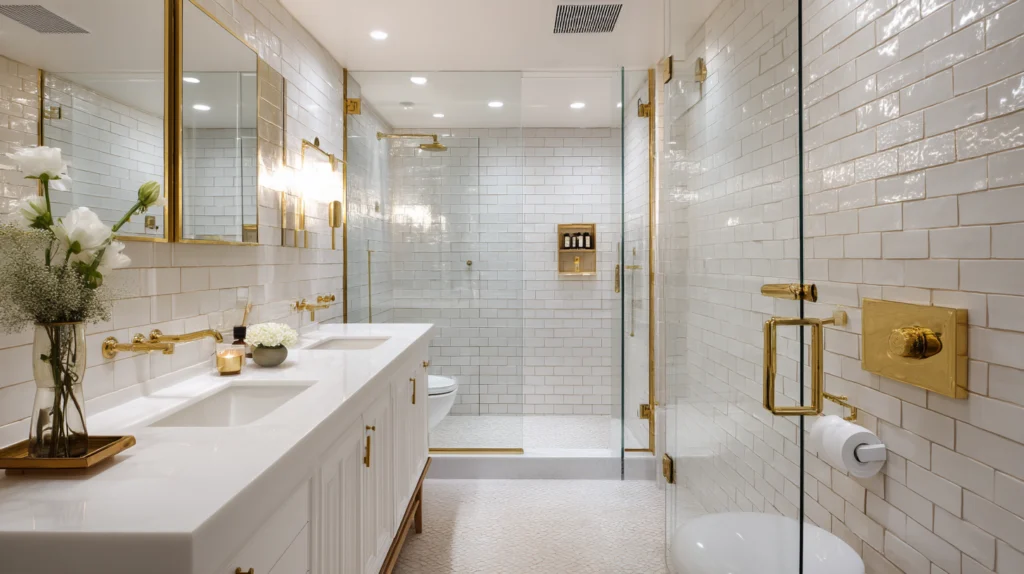
Why Bathroom Remodel Permits Matter
Bathroom remodels are some of the most popular upgrades for Sacramento and surrounding California homeowners. Many homeowners want to know do you need a permit to remodel a bathroom and the answer depends on the scope of work. Any bathroom remodel involves decisions that impact building codes, safety standards, and long term structural integrity. Before beginning a remodeling project it is important to understand the local building department requirements and how the permitting process works in California.
When handled correctly proper permits protect your investment, ensure compliance with strict building codes, and create a safe and fully compliant dream space. A bathroom remodeling permit is more than a formality, it is a safeguard that permits ensure every element of your remodel meets local codes and California building code standards. This includes plumbing systems, electrical systems, hvac systems, ventilation systems, drainage systems, and all structural changes that support the room.
When You Need a Permit for a Bathroom Remodel
Structural Changes That Trigger Permits
Any bathroom remodel involves planning and understanding how a remodel involves structural changes. If the project includes removing walls, moving walls, altering the ceiling, reconfiguring room layouts, cutting into framing, or making significant changes to load bearing elements, you will need a building permit. These types of changes require approval from the local building department because structural integrity and safety codes are involved. Even partial changes like resizing a doorway or expanding a walk in shower can require permits depending on the project type. A building permit is required when the work affects the skeleton of the home and when the bathroom remodel involves elements that tie into the larger home structure.
Plumbing Adjustments and Plumbing Permits
Plumbing adjustments play a major role in permit requirements. You will need a plumbing permit any time you are moving plumbing, installing new supply lines, modifying drainage systems, changing vent piping, or adding new plumbing fixtures such as low flow toilets, tubs, or sinks. Even a walk in shower installation can require permits if the drain or water supply is relocated. Plumbing work must meet the California building code and local building codes which means a permit ensures proper installation, safe performance, and long term reliability. Bathroom remodeling permits for plumbing work are especially important because mistakes can create costly issues behind walls or under floors.
Electrical Work and Electrical Permits
Electrical systems are another major factor in determining if you need a permit. Any electrical work that involves new circuits, electrical rewiring, upgrading breakers, replacing light fixtures that require new wiring routes, or adding new lighting such as recessed lights will require an electrical permit. New lighting layouts, heated flooring systems, fan timers, and GFCI outlet changes usually require permits as well. These rules exist because California has strict building codes that protect homeowners from fire hazards and electrical safety risks. When electrical systems are modified, the building department requires proper documentation to ensure the work is safe.
HVAC and Mechanical Permits
If the bathroom remodel involves changes to hvac systems, ventilation systems, or any mechanical components like a new exhaust fan or heated floor system, you may need a mechanical permit. Mechanical permits cover work that affects airflow, energy usage, and important safety systems. Proper permits are essential when modifying ventilation systems because bathrooms must meet moisture control standards to prevent mold and long term damage.
Accessibility or Layout Adjustments
If your remodel involves layout updates to improve accessibility, widen doorways, or modify circulation space, the building department may require separate permits. These changes affect safety standards, clearances, and room layouts that must align with California building code.
When You May Not Need a Permit

Cosmetic Changes
Not all bathroom remodels require permits. For example, replacing cabinets or vanity pieces, installing new flooring, updating kitchen cabinets in nearby areas, painting walls, swapping plumbing fixtures in the same location, or refreshing hardware does not usually require permits. When the remodel involves surface changes and does not alter systems behind the wall you may not need a permit. However, the local building department still recommends confirming permit requirements before beginning work.
Small Updates That Stay Within Local Codes
Replacing light fixtures with similar fixtures, adding shelves, replacing mirrors, or updating accessories does not typically require approval. These are considered permitted work without additional documentation as long as no new wiring, new plumbing, or structural changes are made.
Always Confirm Locally
California cities like Sacramento and San Diego may follow the same California building code but local authorities may enforce additional requirements. Many homeowners assume surface updates are exempt but if the remodeling project uncovers code violations you may be forced to correct them. A simple call to the building department can save time and frustration.
Understanding Different Types of Bathroom Remodeling Permits
Building Permit
A building permit is required when your remodel involves structural changes, removing walls, modifying framing, altering the footprint, or adjusting window or door openings. Building permits ensure structural integrity and long term safety.
Plumbing Permit
A plumbing permit covers plumbing adjustments, moving plumbing, replacing drain lines, setting new plumbing fixtures, or modifying water systems. It ensures compliance with California building code.
Electrical Permit
An electrical permit is required when electrical work affects wiring, circuits, or load capacity. This includes new lighting, exhaust fan connections, and upgraded outlets.
Mechanical Permit
A mechanical permit covers hvac systems and ventilation systems. This includes new exhaust fans, duct changes, or heated flooring components.
Multi Permit Projects
Larger bathroom remodels often require separate permits for plumbing, electrical, mechanical, and structural work. This ensures every part of the remodel is reviewed during the permit process.
How Much Bathroom Remodeling Permits Cost

Permit fees vary based on city, project type, square footage, and complexity. Some cities charge flat fees while others charge an additional fee based on valuation. Simple permits may cost a few days of processing time and a small fee, while full remodels with multiple permits may cost more. Costs reflect the plan review, permit review, and necessary documentation handled by the building department. Fees ensure the project meets local codes and safety standards.
Understanding the Permit Process
Step 1 Confirm Scope With the Local Building Department
Before you start your remodel you should contact the local building department to confirm what work will require permits. This protects you from unpermitted work issues later.
Step 2 Prepare Detailed Plans
Most bathroom remodeling permits require detailed plans that show the scope of work, plumbing adjustments, electrical work, hvac updates, and all structural changes. These project plans help the building department conduct the permit review efficiently.
Step 3 Submit Permit Applications
Permit applications require documentation of the remodel scope, contractor information, and diagrams. A licensed contractor can handle this step for you.
Step 4 Plan Review and Approval
The building department conducts a plan review to ensure code compliance. This can take a few days or longer depending on the workload.
Step 5 Inspections During the Project
Inspections occur during different phases to ensure safety and compliance. Inspections verify that permitted work meets the necessary permits and building codes.
Step 6 Final Approval
Once all inspections are complete the permit ensures the work is compliant and safe.
Risks of Remodeling Without a Permit
Working without necessary permits creates serious consequences. Unpermitted work can result in fines, forced tear outs, and major issues during a home sale. Potential buyers may request proof of permitted work and may walk away if documentation is missing. Insurance claims may be denied if damage occurs in an area that lacked proper permits. Avoiding the permitting process often leads to costly issues that could have been prevented.
How Capital Construction Helps with the Permitting Process

As a licensed contractor serving the Sacramento region we help homeowners navigate every step of the permit process. We coordinate with local authorities, prepare necessary documentation, and ensure compliance with California building code. Our team manages permit applications, inspections, and all communication with the building department. This creates a smooth, successful remodel and protects your investment.
Frequently Asked Questions
Do I need a permit to remodel a bathroom?
Yes, you need a permit when the remodel involves plumbing adjustments, electrical work, mechanical changes, or structural changes.
Do I need a permit to replace a vanity?
Not usually if plumbing is not moved.
Do I need a permit to replace a shower?
If you replace it in the same location with no plumbing changes you may not need one.
Can I remodel a bathroom myself?
You can but you must follow local codes and obtain the right permits.
How long does the permitting process take?
Processing typically takes a few days to a few weeks depending on complexity.
What happens if I skip permits?
Unpermitted work can lead to serious consequences and expensive corrections.
Final Thoughts
A bathroom remodel involves many moving parts. Understanding permit requirements helps homeowners avoid setbacks and ensures a safe, beautiful dream space. Proper permits protect your investment and ensure compliance with local codes and California building code standards. When in doubt contact your local building department or work with a licensed contractor who can guide you through the permitting process.